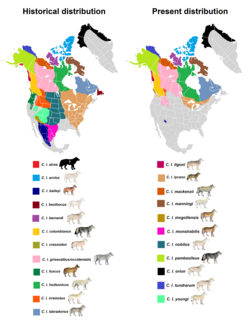| Manitoba wolf | |
|---|---|
 | |
| Scientific classification | |
| Kingdom: | Animalia |
| Phylum: | Chordata |
| Class: | Mammalia |
| Order: | Carnivora |
| Family: | Canidae |
| Genus: | Canis |
| Species: | |
| Subspecies: | †C. l. griseoalbus |
| Trinomial name | |
| †Canis lupus griseoalbus Baird, 1858 [1] | |
 | |
| Historical and present range of gray wolf subspecies in North America | |
| Synonyms [2] | |
| |
The Manitoba wolf (Canis lupus griseoalbus), also known as the grey-white wolf, [3] is an extinct subspecies of gray wolf that roamed in the southern Northwest Territories, northern Alberta, Saskatchewan, and south-central Manitoba. This wolf is recognized as a subspecies of Canis lupus in the taxonomic authority Mammal Species of the World (2005). [2]









